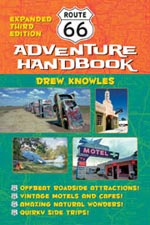Route 66 Adventure Handbook: Updated and Expanded Third Edition, by Drew Knowles
Traveling the entire length of Route 66 from Chicago to Los Angeles, though it inspires many, has never ignited road trip fever in me. For those who do dream of traveling this steeped-in-romance two-lane byway, Knowles' opus will provide a good overview of what is there. His book follows the traditional east-to-west path adopted by most Route 66 chroniclers, and he provides short paragraphs about many of the roadside attractions that can be found along the way. In his introductory section, he warns his readers that "…the information about various features and attractions is not meant to be authoritative" but rather is presented "primarily to whet your appetite for investigation and exploration…" I would add that although the content and breadth of the material presented in this book is, on the whole, excellent, the reader should exercise a certain level of wariness in accepting his narratives about the history of certain attractions as fact. The author tells many a good and intriguing story, but some descriptions of places and events occasionally fall more in the realm of urban legend than what is normally accepted as documented history. There are also occasional factual mistakes.
All that said, the author's collection of black-and-white photographs is excellent and the well-chosen typeface means a passenger can easily read the book aloud while traveling. Route 66 Adventure Handbook is part road guide, part history lesson and part cultural exploration. We learn that both ends of Route 66 have symbolic termination/starting points while the official points lie elsewhere. In Chicago, the traditional endpoint is Lakeshore Drive alongside Lake Michigan. The official starting point is the corner of Adams Street and Michigan Avenue in front of the Art Institute of Chicago. Likewise in Los Angeles the sentimental start/finish location is the Santa Monica Pier, which is in reality a few blocks south of the official end of road at the corner of Santa Monica Boulevard and Ocean Avenue. Knowles' descriptions of the towns and cities along the route reveal the birthplaces of many American cultural icons like corn dogs, cheeseburgers, mail order businesses, architectural masterpieces, and natural wonders. Historical anecdotes like the naming of Joliet, Illinois, are not only entertaining, but also engender appreciation for the living history still to be found along this famous roadway.
Knowles makes the point that travelers journeying in the traditional westward direction will be afforded a unique glimpse into the creation of the American psyche as populations of the east gradually made their way west to California and the Pacific Ocean. Regardless of the philosophical orientation, travel direction, and motivation of today's roadtrippers, this book points the way to roadside wonders like the albino squirrels of Marionville, Missouri, the Totem Pole Park in Foyil, Oklahoma, the enormous ball of barbed wire in McClean, Texas, and Exotic World near Helendale, California.
Throughout the book, Knowles uses an icon of a vintage Corvette to identify insider tips for finding and exploring little-known segments of Route 66. He also does an excellent job of providing pointers and suggestions for finding attractions a short way from the main path of the highway. An unexpected bonus is his description of sixteen additional historical routes including U.S. Route 20, the Trail of Tears, and the Lewis & Clark National Historic Trail. The author also provides an excellent list of tourist services for each of the eight states through which Route 66 travels between Chicago and the Pacific Ocean.
For the price, this book is an outstanding value and a terrific resource for anyone interested in Route 66, whether traveling by car, RV, motorcyvle, or armchair.
Mark
Sedenquist
7/9/06

